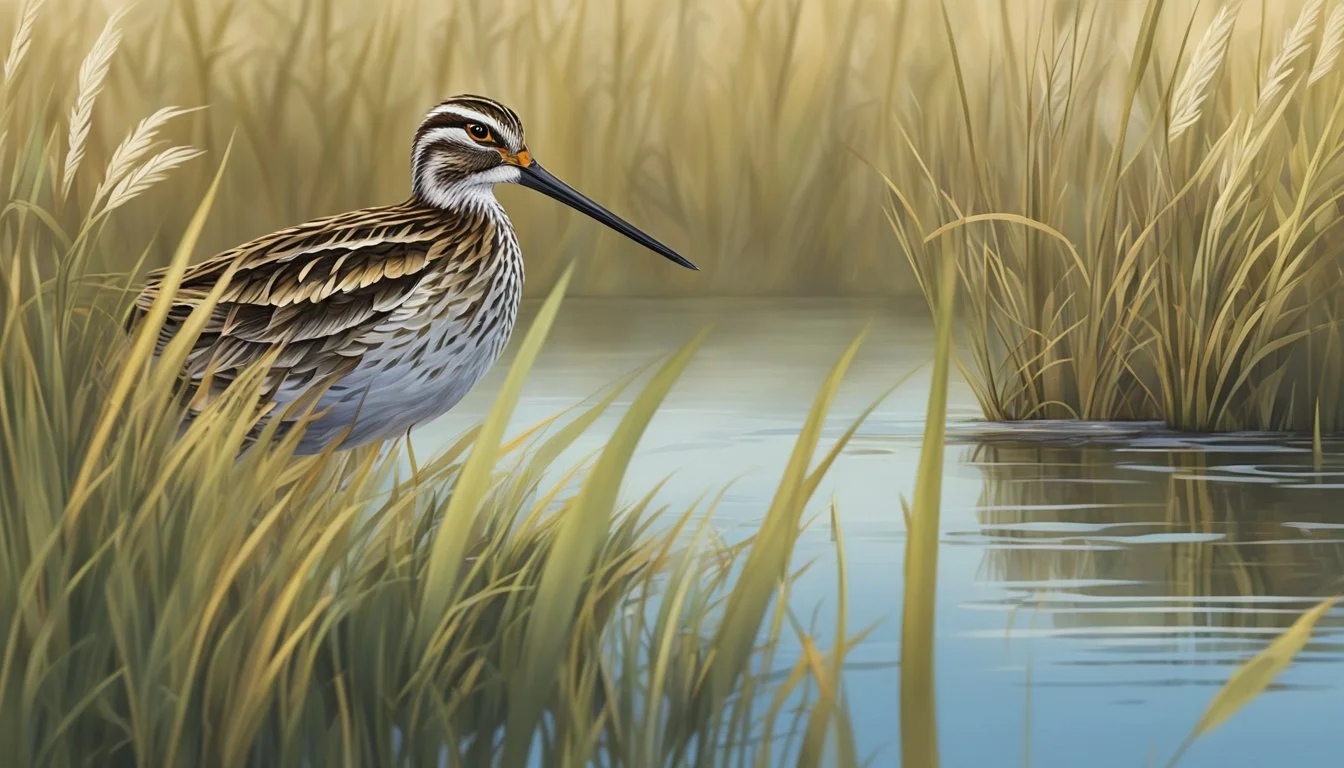Snipe Hunting Seasons
Understanding Regional Regulations and Timelines
This Article is Part of Our Guide on Hunting Seasons for Over 70 Common Game Species
Snipe hunting is a storied tradition that dates back centuries, particularly in the rural parts of the United States. The snipe, a real bird species that is part of the Scolopacidae family, is often associated with a practical joke of sending the uninitiated on a fruitless hunt. However, for the true hunter, snipe provide a legitimate and challenging game bird opportunity. Snipes are migratory birds and are most commonly found in wetlands and marshy areas where they are well camouflaged among the vegetation.
Seasonally, snipe hunting is regulated and varies by state, with most hunting seasons opening in the fall and extending through the winter months. For instance, in Alabama, the snipe hunting season typically runs from early November through the end of February, aligning with the bird's migratory patterns. Hunters are allowed a daily bag limit, which can be up to eight birds per hunter. These regulations are in place to maintain healthy populations and ensure sustainable hunting practices.
Engaging in snipe hunting offers hunters not just the pursuit of game but also an experience that taps into the essence of traditional hunting. The activity presents both physical and skill-based challenges, requiring hunters to navigate tricky terrain and demonstrate sharp shooting abilities. Snipe hunting contributes to wildlife management and conservation efforts, as regulated hunting is a tool used by wildlife biologists to help maintain balanced ecosystems.
Snipe Hunting Overview
Snipe hunting is a traditional outdoor activity that challenges hunters with the pursuit of a fast and elusive game bird. Each hunting season, enthusiasts gear up to locate and harvest snipe, a bird known for its unique behavior and habitat preferences.
Understanding Snipe Hunting
Snipe hunting refers to the pursuit of the common snipe (Gallinago gallinago), a migratory game bird found in wetland areas. Hunters typically seek out these birds during the designated season, which varies by region but often falls within the autumn and winter months. For instance, in Alabama, the snipe hunting season runs from November 11th through February 25th.
Bag Limit: Depending on the location, there may be daily limits set on the number of snipe that can be harvested. This precaution ensures sustainable hunting practices.
Habitat: Snipe are prevalent in wetter regions, favoring marshy terrain where their cryptic plumage provides excellent camouflage.
Technique: While hunting snipe, hunters should be patient and silent as the birds are alert and quick to take flight with rapid, erratic patterns.
Importance of Conservation
Conservation plays a vital role in snipe hunting, ensuring that the snipe populations remain stable and the ecosystems they occupy are protected. Hunters must respect wildlife management guidelines, including season dates and bag limits, which are often strictly regulated to support conservation efforts.
Conservation Efforts:
Regulated Seasons: Authorities set specific hunting dates to avoid disrupting breeding periods and migratory patterns.
Habitat Management: The maintenance of healthy wetlands is crucial for the continued survival of snipe populations.
By adhering to these conservation principles, hunters contribute to the wellness of the species and the broader environment, enabling the continued tradition of snipe hunting for future generations.
Snipe Biology and Habitat
The snipe is a migratory bird known for its elusive nature and the unique habitat preferences that dictate its distribution and abundance.
Physical Characteristics
The Wilson's Snipe (Gallinago delicata) is a medium-sized, stocky bird with short legs and a long, straight bill. This bill, typically about 2.5 to 4 inches in length, is highly flexible and sensitive at the tip, enabling the snipe to forage for food. Their cryptic brown, black, and white feathers provide excellent camouflage against their natural habitat, making them challenging targets for hunters.
Length: 9.8 to 11.4 inches
Wingspan: 16 to 18 inches
Weight: 3.2 to 4.7 ounces
Snipe Habitat Distribution
Snipe primarily inhabit wetlands, including marshes, muddy fields, and along the edges of ponds and rivers. These areas provide the soft, muddy ground necessary for the snipe to probe with its bill for food, such as worms and other invertebrates.
Common features of snipe habitat include:
Wet, muddy areas with dense vegetation
Short to moderately tall emergent vegetation for cover
Access to open areas for foraging
During migration, snipe can also be found in coastal areas, making strategic use of different terrains throughout the year. Their habitat range spans over many geographic regions where conditions align with their needs for cover and food availability.
Legal Considerations
When planning to hunt snipes, hunters must first ensure they are in compliance with state and federal regulations. Not only do these regulations help protect the species and its habitat, but they also establish specific guidelines pertaining to hunting seasons, required licenses, and bag limits.
Hunting Regulations
State wildlife agencies set the hunting season for snipes, which can vary by region. Season dates might start as early as November and extend through February, providing hunters with a span of time during the migratory patterns of these birds. Federal frameworks guide these state-level decisions to ensure alignment with conservation efforts. Hunters are required to follow these specified dates and are prohibited from hunting outside of the established season.
The use of lead shot for hunting snipes is generally prohibited due to the harmful effects on both the environment and wildlife. Hunters should use non-lead alternatives when harvesting these birds.
Licenses and Bag Limits
Before hunting, individuals must obtain a hunting license. The requirement for a license applies to all hunters and serves to regulate hunting activities. Licenses can often be acquired through a state's wildlife agency or an authorized vendor.
The bag limit for snipes is determined by state agencies, which decide the number of birds a hunter can legally harvest per day. For example, in some states like Alabama, hunters may be permitted to take up to 8 snipes per day. These limits are in place to ensure sustainable hunting practices.
It is the responsibility of the hunter to familiarize themselves with these legal considerations and adhere strictly to the limits and regulations set forth by governing bodies for the preservation of migratory birds and their habitats.
Hunting Equipment and Techniques
In pursuing the elusive snipe, hunters must equip themselves with the proper gear and master specific hunting techniques. This section breaks down the essential equipment and strategies employed during a snipe hunt.
Essential Gear
Gun: A reliable shotgun is the hunter's primary tool. While some hunters prefer break-action shotguns for their simplicity and reliability, others opt for autoloaders for their rapid-fire capability.
Shells: Hunters should select the appropriate gauge and shot size for snipes; often a smaller shot size like #7 1/2 is recommended.
Boots: Waterproof boots are crucial for navigating wetlands where snipes are commonly found.
Burlap Sack: A traditional item used in snipe hunting is a burlap sack, which can serve as a means to carry successfully harvested birds.
Additionally, hunters might consider:
Camouflage clothing to blend into the environment.
A hunting dog that can assist in flushing out snipes.
Hunting Techniques
Ambush: Hunters often employ an ambush technique, remaining still and quiet to not alarm the birds before taking a shot.
Spotting: Snipe hunting involves careful observation; hunters must spot the birds before they take flight.
Light: A flashlight can be used in traditional snipe hunts at night to startle and locate the birds, although this practice isn't as common in modern hunting scenarios.
Dogs: A well-trained dog enhances the hunting experience, helping to locate and retrieve snipe without damaging the game.
Flush and Shoot: The most common modern method involves walking through likely snipe habitat to flush the birds and take a shot during their rapid, erratic flight. The American woodcock, a species related to the snipe, is often hunted using this technique as well.
Seasonal and Geographical Factors
The snipe hunting season is influenced by both geographical location and time of year. Regulatory periods across North America vary, reflecting local ecological conditions and snipe migratory patterns.
Snipe Hunting by Region
In North America, snipe hunting regulations are defined by state and provincial wildlife agencies, with seasons typically aligned with the birds' migration habits. Florida, for instance, opens its season earlier than most due to its southern location, which snipes frequent earlier in their southward migration. By contrast, states like Kansas and Missouri may see later season openers.
Kansas: Variable start, often in October or November
Florida: September to December
Michigan: Typically opens in September
Texas: November to February
Missouri: Later fall through winter
Georgia, Louisiana, Mississippi, Arkansas: Fall to winter, with slight regional variations
Northern locales such as Canada, Michigan, and Alaska usually have earlier openers. The season in Canada, for example, may begin as early as September. Alaska's season is generally short and early due to the birds' migration to warmer climates.
Southern states like Texas, Louisiana, and Mississippi have their seasons set to capture the snipe's arrival on their southward journey, often extending into winter months.
Weather and Seasonal Patterns
Weather patterns have a significant impact on snipe behavior, influencing hunting seasons and success. Snipes prefer wetland habitats, with migration and breeding habits syncing with seasonal weather changes. Migratory flow from northern regions like Canada and Alaska commences as cold weather sets in, leading to increased snipe presence in southern states throughout the fall and winter.
Typical Seasonal Patterns:
September: Start of migration in northern states and Canada
October to November: Peak migration through central states, including Michigan and Missouri
December to February: Southern states like Texas and Florida see higher snipe populations
Hunters must pay close attention to local weather conditions, as these birds respond rapidly to changes, seeking out soft, muddy grounds for feeding, regardless of the season. Sudden weather shifts can cause snipes to move en masse, either advancing or delaying their presence in a particular region.
Hunting Culture and Traditions
Snipe hunting is rooted deeply in tradition, combining skilled wingshooting with a rich sense of community and a commitment to conservation.
Hunting as Tradition
In the United States, the tradition of snipe hunting, often colloquially termed as hunting for marshdoodles, is a storied part of American hunting culture. This bird's erratic flight makes it a challenging target for even seasoned hunters, positioning snipe hunts as a prestigious wingshooting activity. Snipe, an upland game bird, are pursued in varying landscapes, from the Everglades in South Florida to the diverse ecosystem around Lake Okeechobee.
Organizations like the NAVHDA Palmetto Chapter unite enthusiasts who keep the tradition of bird hunting alive through events and training sessions. Participants often engage with versatile hunting dogs like the American Brittany to maneuver through the low country, pursuing not just snipes but perpetuating customs that have been passed down through generations.
Community and Conservation
The social aspect of snipe hunting extends beyond the mere act of hunting. Across the coastal marshes and inland wetlands, communities often engage in snipe hunts as forms of social gatherings, enhancing the fabric of local culture. Events that bring hunters together serve as a platform for education and sustainability practices.
Conservation efforts are at the forefront, especially in regions influenced by the Salt Life philosophy, where preserving the balance of marine and wetland ecosystems is paramount. Hunters typically respect the snipe season regulations, which in some areas, like Alabama, stretch from November to February. Adherence to bag limits, such as a daily restriction—often eight birds per hunter—is commonplace, ensuring that snipe populations remain stable for future generations of the hunting fellowship to enjoy.
Preparing and Cooking Snipe
After a successful snipe hunt, one is rewarded with both the sport of hunting this challenging game bird and the potential for excellent table fare. The key to an exceptional eating experience lies in proper preparation and cooking methods, transforming the elusive snipe into a delightful meal.
Field Dressing
Field dressing is the first essential step after harvesting a snipe. They should act quickly to ensure that the bird's meat remains fresh and free from contaminants. Field dressing involves removing the innards, which can be accomplished by making a careful incision near the bird's vent. Hunters remove the entrails, taking care not to puncture the intestines, which can spoil the meat.
Cooking Methods
There are several methods to cook snipe, each bringing out a unique flavor and texture profile of the bird's meat.
Roasting is a traditional approach that highlights the natural flavors. They preheat the oven to a high temperature, usually around 475°F - 500°F. The snipe is then arranged in an ovenproof pan with a small amount of water to prevent drying out. Cooking should be brief, usually around 5 minutes, then followed by basting with a generous amount of butter, lard, or olive oil to add moisture and richness.
For the adventurous cook, snipe can also be grilled or pan-fried, showcasing a different aspect of its gamey yet subtly delicate taste. When grilling, it's essential to keep the bird moist by marinating or basting regularly. In pan-frying, the snipe benefits from a simple dredging in seasoned flour and a quick sear in hot oil or butter for a crisp outer layer and tender interior.
Whichever method chosen, the cook must ensure the snipe is cooked just to the right temperature, retaining its unique texture while taking care to not overcook this fine game bird.
Conservation and Habitat Management
Effective conservation and habitat management are vital for the sustainability of snipe populations and their environments. These efforts ensure the balance of the ecosystem and support the migratory patterns of various waterfowl.
Habitat Preservation Activities
Habitats crucial for common snipe and other shorebirds, including migratory bird species, often comprise of wetlands found in central and northern regions. These wetlands provide essential resources for foraging, nesting, and protection. Habitat preservation activities include:
Restoration of Wetlands: Reestablishment of hydrological structures to support the natural ecosystem.
Invasive Species Control: Removal or reduction of non-native plant and animal species that threaten the native habitat.
Pollution Mitigation: Cleanup projects targeting pollutants that degrade water and soil quality.
Role of Hunters in Conservation
Hunters play a pivotal role in the conservation of snipe and other waterfowl populations. They contribute both financially and through direct involvement in habitat management. Notable points regarding hunters' contribution include:
Funding: License fees and permits, such as the Snipe Permit for designated hunts, support conservation efforts.
Regulatory Compliance: By following season dates and regulations, hunters aid in maintaining sustainable populations.
Hunter-led Initiatives: Many hunters participate in or support habitat restoration and wildlife management projects, often in collaboration with state agencies and conservation groups.
Additional Resources
To effectively pursue snipe hunting seasons across diverse habitats, hunters may seek additional resources for support and education. These resources provide vital information ranging from identification of snipe habitats to understanding their behaviors and the nuances of hunting these migratory birds.
Organizations and Groups
Various organizations offer hunters guidance on snipe hunting, detailing public lands access and conservation efforts. These groups may also provide community support and advocacy for preserving snipe habitats.
Public Lands Information: Organizations often list available public lands suitable for snipe hunting, such as marshy wetlands, cow pastures near drainage ditches, and bottomlands which snipe frequent.
Conservation Efforts: To ensure the sustainability of snipe populations, groups focus on the conservation of critical habitats, including woods and upland birds’ habitats across the coast and the West.
Educational Material
Education is key in understanding snipe behavior, such as their unique plumage, which aids in camouflage amongst the dark, damp environments like potholes, and river and lake edges.
Identification Guides: Detailed guides help hunters distinguish snipes by their plumage, providing tips for spotting these birds in their natural, often marshy or dark environments.
Hunting Techniques: Material covering effective hunting methods, including strategies for close-range hunting in dense Alabama wetlands or navigating through cow pastures and along the coast.









